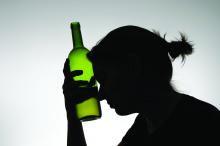Nearly one in eight adults in the United States had been diagnosed with alcohol use disorder in 2012-2013, a nearly 50% increase from a decade earlier, according to a study published Aug. 9. Other substantial increases occurring across virtually all demographic groups included overall 12-month alcohol consumption and high-risk drinking, particularly among adults aged 65 and older, racial/ethnic minorities, women, and those with lower education and incomes.
“The marked increases in high-risk drinking and DSM-IV [alcohol use disorder] between 2001-2002 and 2012-2013 also mirror recent sharp increases in morbidity and mortality from diseases and injuries in which alcohol use has a substantial role or deceleration of previously seen declines,” wrote Bridget F. Grant, PhD, of the National Institute on Alcohol Abuse and Alcoholism (NIAAA) in Rockville, Md., and her associates. High-risk drinking was defined as five drinks (14 g of ethanol each) per occasion for men and four drinks per occasion for women at least weekly.
“Most important, mortality rates of all cardiovascular diseases and stroke decelerated between 2000-2001 and 2011-2014 after 3 decades of decline,” they wrote. Increases also occurred in hypertension morbidity and mortality, hypertensive emergency department visits, death rates from liver cirrhosis, and alcohol-related emergency department visits tied to falls, Dr. Grant and her colleagues authors reported.“Mortality among alcohol-affected drivers who were simultaneously distracted also increased between 2005 and 2009 by 63%,” they wrote (JAMA Psychiatry. 2017 Aug 9. doi: 10.1001/jamapsychiatry.2017.2161).
The researchers analyzed data from 43,093 respondents to the National Epidemiologic Survey on Alcohol and Related Conditions (April 2001-June 2002) and from 36,309 respondents to the National Epidemiologic Survey on Alcohol and Related Conditions III (April 2012-June 2013). Both surveys involved face-to-face interviews with a nationally representative sample of U.S. adults.
The findings showed that 12-month alcohol use had increased 11.2% between 2001-2002 and 2012-2013, from 65.4% to 72.7%. A substantial increase also occurred in high-risk drinking and alcohol use disorder as defined in the DSM-IV. High-risk drinking increased 29.9% during that time, from 9.7% to 12.6%, representing an increase of approximately 9.4 million Americans engaging in high-risk drinking.
Alcohol use disorder (AUD) increased 49.4%, from 8.5% to 12.7% – a percentage that accounts for an additional 12.3 million Americans with the diagnosis. That increase dwarfs the 14.8% increase in alcohol use disorder that was seen between 1991-1992 and 2001-2002, the authors pointed out. The prevalence of 12-month AUD rose significantly among adults aged 65 and older (106.7%), African American individuals (92.8%), and women (83.7%). Interestingly, all subgroups reported significant increases in AUD except for Native Americans and people living in rural areas. By comparison, the 12-month prevalence of AUD among men increased by a third (34.7%), and their high-risk drinking increased 15.5%.
“Drinking norms and values have become more permissive among women, along with increases in educational and occupational opportunities and rising numbers of women in the workforce, all of which may have contributed to increased high-risk drinking and AUD in women during the past decade,” the authors wrote. “Stress associated with pursuing a career and raising a family may lead to increases in high-risk drinking and AUD among women.”
These increases indicate potential future increases among women in alcohol-related conditions, such as breast cancer and liver cirrhosis. Increases may also occur in fetal alcohol spectrum disorder and exposure to violence, the authors wrote.
The increases in alcohol use, high-risk drinking, and AUD found among minorities may be related to increased stress and demoralization as wealth inequality widened between minorities and whites in the wake of the 2008 recession. Other inequalities, such as income and educational disparities, unemployment, residential segregation, discrimination, and less health care access may also play a role in those increases, the authors wrote.
One limitation of the study is that certain populations were not surveyed, such as homeless individuals and people who are incarcerated. This means that the prevalence of alcohol use, high-risk drinking, and AUD could be underestimated, Dr. Grant and her colleagues said. However, they said, the large sample sizes of the surveys might balance out that limitation and others.
Nevertheless, the increases found in alcohol use, high-risk drinking, and AUD “constitute a public health crisis that may be overshadowed by increases in much less prevalent substance use (marijuana, opiates, and heroin) during the same period,” Dr. Grant and her colleagues wrote. “The findings herein highlight the urgency of educating the public, policymakers, and health care professionals about high-risk drinking and AUD.” In addition, they called for broader effors to address the “individual, biological, environmental, and societal factors” influencing high-risk drinking and AUD.
The research was sponsored by the NIAAA, and funded by the National Institutes of Health. The authors reported having no disclosures.


